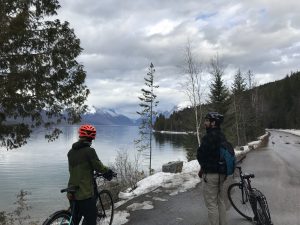By Carly Campbell
Earth Day is annually April 22. In the sustainability world, April signifies an “Earth Month,” this large spring-time opportunity to host events, presentations and talks. Zealous outreach is more than expected at a time of year when the public is open to receiving it. At St. Patrick Hospital, nurses have been approaching the Green 4 Good staff with questions to the point of “well, it’s Earth time, what have you Earth Green Life people cooked up for us?”
Don’t worry, we cooked up plenty. Earth celebrations started early on in April, with tabling for CSA produce shares and education panels on paper-use reduction. The Saturday before Earth Week, St. Patrick Hospital joined with the Clark Fork Coalition to mobilize the Clark Fork River Cleanup, bringing out around fifty nurses and their families to scour the river banks for trash.
On Earth Day itself, we hosted nature and climate related TED talks all day for cycling groups of nurses and staff. There was a raffle, tabling, giveaway items; a presentation on the Awards the hospital recently won for medical and chemical waste reduction; and an afternoon organized trash pickup on hospital grounds. Over at the University of Montana, there was SustainaGanza, with overhauled recycling guides and E-Waste demonstrations. Throughout the week, UM dining and I conducted a very public and educational food waste audit in the dining hall. As I write this, upcoming yet is a Sustainability Awards Breakfast, essentially the Oscars for the green-collar work force on campus.
All of these events require a certain amount of storytelling. Not in the fabrication sense of the word, but in choosing what parts to tell, and building a narrative. Storytelling means standing in front of a crowd, and announcing the year’s successes and challenges without diving too far into nitty-gritty details. You have to drive home the climate crisis and needs of our environment, while ending on an optimistic note to call them to action – without bringing worries within the industry up to the front. You have to explicitly lay out why sustainable efforts are worthwhile.
Celebratory education is a spotlight, and one I personally find challenging. I have always been a person who is happy to do the legwork and my get hands dirty. But I struggle to be polished and charismatic on stage. The stage of Earth Month, Week, and Day can be a high-stress gauntlet of events where eyes are highly focused on these programs.
That said, the stories are important to tell, and someone has to have the energy and passion to get up and tell them. During the afternoon trash pickup at the hospital, I was able to talk for some time about “stories” with my supervisor Beth Schenk. She is someone who has dedicated her life to standing on the stage of Sustainability, and rallying those around her to action. She has a podcast, speaks at conferences, teaches classes, heads committees, and has established an entire educational platform to reach healthcare providers around the country (Nurse’s Climate Challenge through Alliance of Nurses for Healthy Environments). She’s an inspiration to me, but also has an intimidating amount of energy for this line of work.
Beth receives a large amount of attention at presentations, because she is well-known in her field, and an incredibly charismatic person. When she tells stories of success, she gauges exactly how much information her audience is prepared to absorb, where they want details, and where they want to just be told what’s what. She says it is a matter of experience – but clearly it is also her excellence at the craft of public speaking.
As we walked along in the spring sunshine, picking up cigarette butts and bits of plastic from behind the hospital parking lot, Beth told me a bit about how she got to where she is. I am always interested in these kinds of stories. She started in Botany in college, although her summer jobs were with nurse caretakers. She talked about liking the personality of these nurses – efficient but friendly, confident and usually funny, and dedicated to helping people. Essentially, she decided to become a nurse “for a couple years” because she admired the gumption of those in the field. Her passion for plants, nature, and the environment never waned, but she ended up tying it into healthcare because that’s the world she found herself thriving in.
Presenting sustainability efforts well might be less about charisma and the perfectly crafted story, and more about the warmth, honesty, and passion that you represent it with. This is my food for thought as I look on over the next set of weeks and wonder how many times I will have to get in front of an audience and introduce myself. For the sixty-third time… “Hello, my name is Carly Campbell, and I am an Energy Corps member serving here at….”








